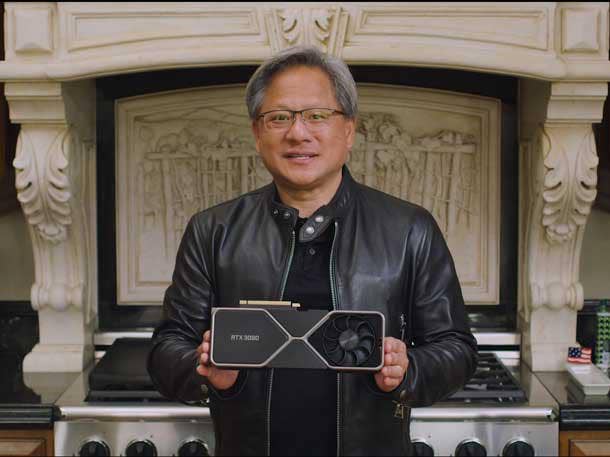Nvidia Unveils GeForce RTX 30 Series, ‘Biggest Generational Leap’ In Graphics
Nvidia says the second-generation RTX cards, which includes the flagship GeForce RTX 3080, provide up to two times the graphical performance and 1.9 times the power efficiency over the chipmaker‘s previous Turing-based cards. ’Today’s Ampere launch is a giant step into the future,’ CEO Jensen Huang says.

Nvidia revealed its next generation of RTX graphics cards, including the flagship GeForce RTX 3080, which CEO Jensen Huang said represent the company’s “biggest generational leap” in graphics performance.
Huang said the second-generation RTX cards, which also include the new mid-tier GeForce RTX 3070 and Titan successor GeForce RTX 3090, provide up to two times the graphical performance and 1.9 times the power efficiency over Nvidia‘s previous Turing-based cards while offering competitive prices.
[Related: Nvidia-Arm Deal Could Be Reached In ‘Next Few Weeks’: Report ]
The Tuesday reveal comes after Nvidia in May launched the first product based off its new Ampere architecture, the A100 data center GPU, which unifies training and inference into one architecture and can be partitioned into seven distinct GPU instances using the new multi-GPU instance feature.
The founder‘s edition of GeForce RTX 3080 is set to come out first, on Sept. 17 for $699, the same price as the previous generation RTX 2080 Super while offering significantly better performance. The graphics card comes with 8,704 CUDA cores, 10 GB of GDDR6X RAM and a boost clock of 1.71 GHz.
The founder‘s edition of the GeForce RTX 3090, which the company said is its first 8K gaming GPU, will follow on Sept. 24 for $1,499 — $1,000 less than its predecessor, the RTX Titan, and slightly higher than Nvidia‘s previous mainstream flagship card, the RTX 2080 Ti. The card comes with 10,496 CUDA codes, 24 GB in GDDR6X RAM and a boost clock of 1.7 GHz.
The founder‘s edition of the mid-tier GeForce RTX 3070 will launch in October for $499, the same as the previous generation RTX 2070 Super while offering greater performance than the $1,199 RTX 2080 Ti. The card comes with 5,888 CUDA cores, 8 GB in GDDR6 RAM and a 1.73 GHz boost clock. Nvidia did not announce a successor to the RTX 2060 Super.
Based on Nvidia‘s new Ampere architecture, the GPUs powering the graphics cards come with streaming multiprocessors that provide twice the throughput for single-precision floating-point math, when compared to Turing. The GPUs also double the throughput for ray tracing performance with second-generation Ray Tracing cores and for artificial intelligence with third-generation Tensor Cores, which enables Deep Learning Super Sampling 2.0 possible.
The new GeForce RTX graphics cards require a PCIe 4.0 connection, meaning only AMD‘s third-generation Ryzen processors can take advantage of them as Intel has yet to deliver desktop processors that can support that level of connectivity.
In a virtual presentation Tuesday, Huang pitched the new graphics cards, which will include models made by add-in board partners, as a game-changer for the PC gaming market, particularly because of how he thinks it will lead to more gamers taking advantage of ray tracing in games to render realistic lighting and reflections in real time.
“Today‘s Ampere launch is a giant step into the future. This is our greatest generational leap ever,” he said. “The second-generation Nvidia RTX, fusing programmable shading, ray tracing and artificial intelligence, gives us photorealistic graphics and the highest frame rates. At the same time, once the holy grail of computer graphics, ray tracing is now the standard.”
Nvidia also revealed new software to take advantage of its graphics cards: Nvidia Reflect, which optimizes the rendering pipeline across CPU and GPU to reduce latency in games by 50 percent; Nvidia Broadcast, a live-streaming tool that uses AI to remove background audio noise and create virtual background effects; and Nvidia Omniverse, a tool for making movies using game assets.